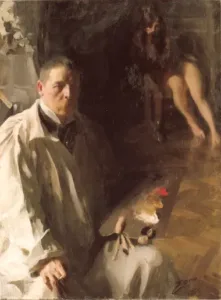The Zorn Palette
In the vast tapestry of art, color has the power to evoke emotions, tell stories, and create worlds. The Zorn palette, named after the Swedish maestro Anders Zorn, is a testament to the beauty that can be achieved through a limited yet harmonious selection of colors. With just four pigments—yellow ochre, vermilion, ivory black, and titanium white—this palette has become a favorite among artists seeking simplicity with a profound impact.
The Palette Colors:
A warm, earthy yellow, yellow ochre forms the basis for the Zorn palette. Its muted tones serve as an excellent foundation for capturing the subtleties of light and shadow, particularly in flesh tones and landscapes.
2. Vermilion:
Vibrant and rich, vermilion adds a burst of warmth to the palette. This red-orange hue is crucial for capturing the intensity of sunlit areas, creating dynamic contrasts, and infusing vitality into the artwork.
3. Ivory Black:
In contrast to conventional palettes, the Zorn palette includes ivory black instead of a true blue pigment. This deep, neutral black contributes to the creation of nuanced shadows, adding depth and dimension to the composition.
The sole representative of light in the palette, titanium white is indispensable for creating highlights, adjusting tonal values, and achieving a full spectrum of tints when mixed with the other colors.
Prominent Artists and Their Works:
1. Anders Zorn (1860-1920):

Zorn’s mastery of the Zorn palette is evident in his iconic works such as “Self-Portrait with Model” and “Isabella Stewart Gardner in Venice.” His ability to capture the warmth and vitality of his subjects, especially in flesh tones, showcases the potential of this limited color scheme.
2. John Singer Sargent (1856-1925):

John Singer Sargent experimented with the Zorn palette in works like “Madame X” and “The Daughters of Edward Darley Boit.” Sargent’s adept use of vermilion and ivory black highlights the palette’s effectiveness in conveying both subtlety and drama.
The Zorn palette, continues to captivate artists and enthusiasts alike. As seen in the works of Anders Zorn, and John Singer Sargent, this limited color scheme unlocks a world of possibilities, emphasizing the importance of skill and intentionality. With just four colors, the Zorn palette proves that less truly is more.
